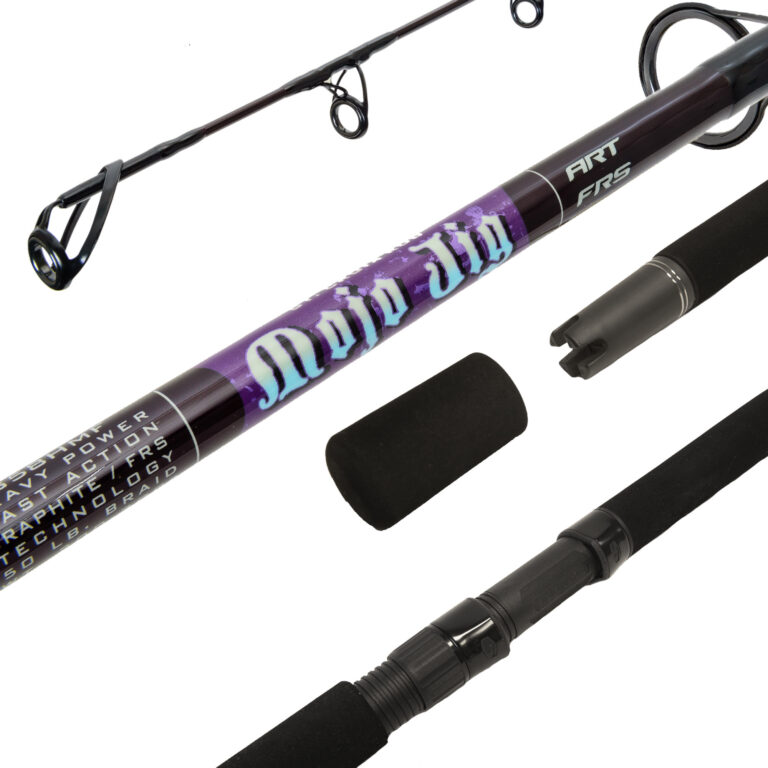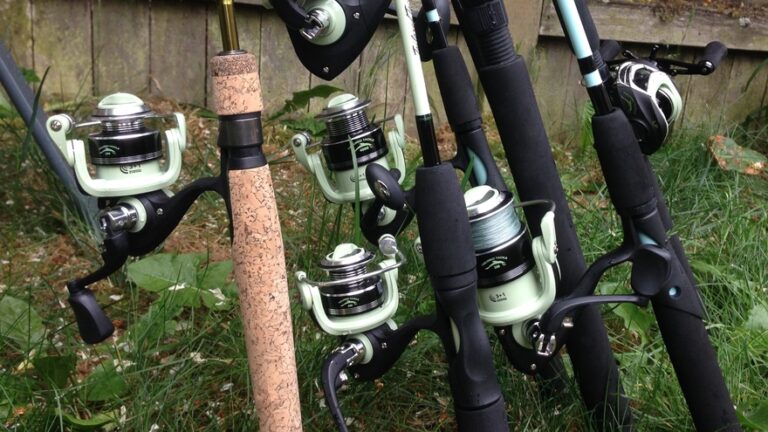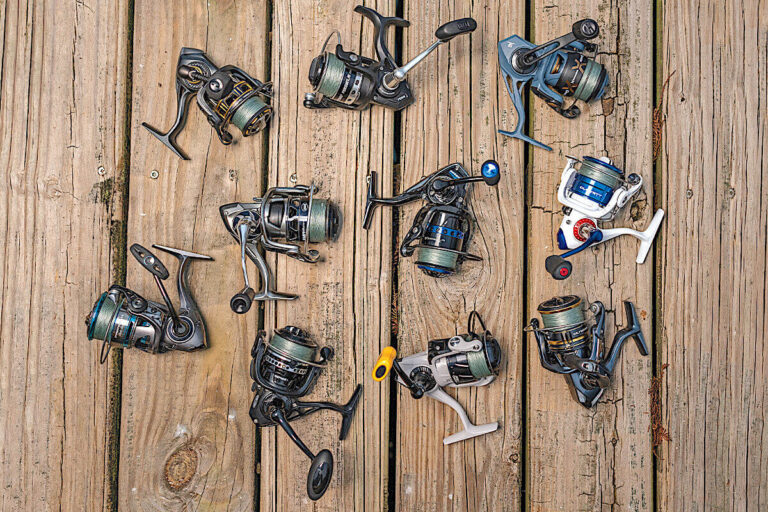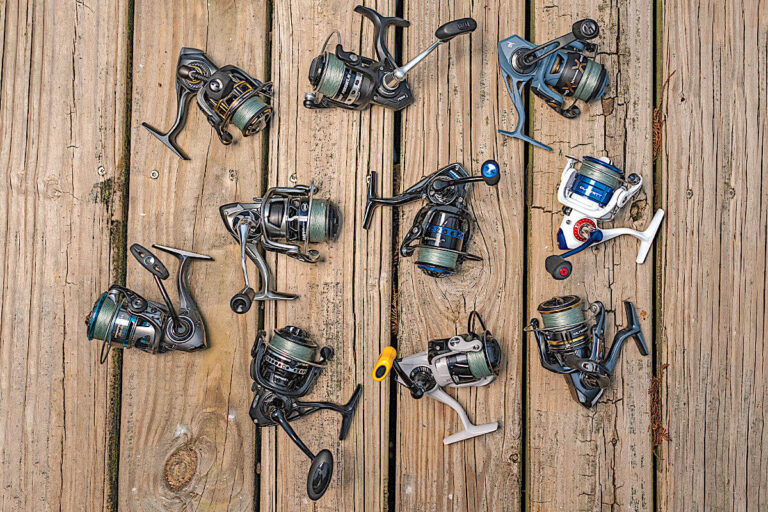To properly set up a spinning rod and reel combo, follow these steps: attach the reel to the rod, spool the line onto the reel, and secure the reel handle. Ensure that the equipment is assembled correctly for efficient and effective fishing.
Setting up a spinning rod and reel combo is a crucial step in preparing for a successful fishing adventure. Whether you are a beginner or an experienced angler, it is essential to master the proper setup to maximize your chances of catching fish.
By following a few simple steps, you can ensure that your spinning rod and reel are ready to tackle any fishing situation. In this guide, we will provide a concise and straightforward explanation of how to properly set up your spinning rod and reel combo, from attaching the reel to spooling the line and securing the reel handle. Get ready to hit the water and reel in some big catches!
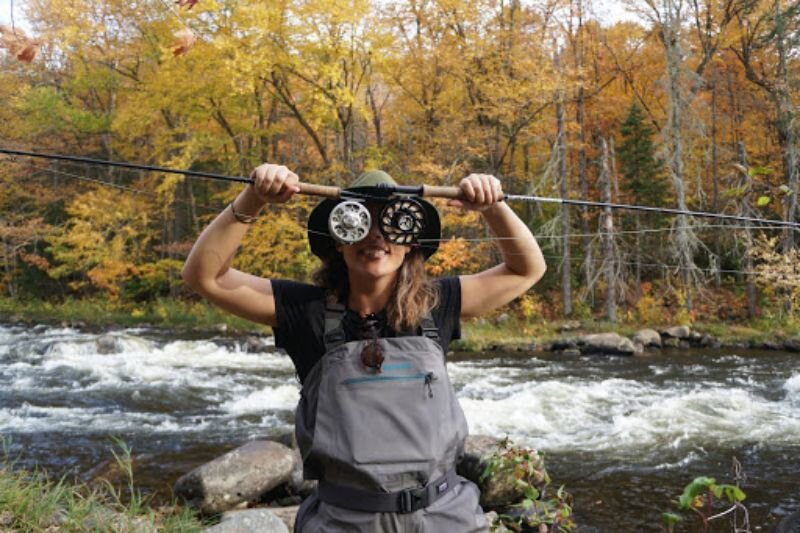
Credit: www.treelinereview.com
Understanding The Components Of A Spinning Rod And Reel Combo
Are you new to fishing and wondering how to properly set up your spinning rod and reel combo? Understanding the components of a spinning rod and reel combo is the first step to a successful fishing experience. In this section, we will delve into the anatomy of both the spinning rod and reel, as well as share some tips on selecting the right combo for your needs.
Let’s dive in!
The Spinning Rod
A spinning rod is a crucial component of your fishing setup. Here are the key points to know about the anatomy of a spinning rod:
- Rod length: The length of a spinning rod can vary, typically ranging from 5 to 9 feet. The length you choose depends on the type of fishing you plan to do. Smaller rods are suitable for fishing in tight spaces or targeting smaller fish, while longer rods provide better casting distance and leverage for larger fish.
- Power and action: Power refers to the rod’s strength or resistance to bending, while action relates to where the rod flexes and how quickly it snaps back. Common power ratings include light, medium, and heavy, while action options include fast, medium, or slow. Consider the species of fish you’ll be targeting to determine the appropriate power and action for your spinning rod.
- Material: Spinning rods are commonly made from fiberglass or graphite. Fiberglass rods tend to be more durable and offer better flexibility, making them ideal for beginners. On the other hand, graphite rods are lighter, more sensitive, and provide better casting accuracy.
Selecting The Right Spinning Rod For Your Needs
When it comes to selecting the right spinning rod for your needs, consider the following:
- Target species: Determine the size and weight of the fish you plan to catch. Different species require different rod strengths and actions.
- Fishing location: Consider the fishing environment you’ll be in. Will you be fishing in freshwater or saltwater? Will you be fishing from a boat or the shore? These factors will influence the type of spinning rod you choose.
- Budget: Set a budget for your spinning rod. While there are options for every price range, keep in mind that quality rods often come with a higher price tag. Investing in a high-quality rod will ensure better performance and durability in the long run.
The Spinning Reel
Now let’s shift our focus to the spinning reel, which plays an essential role in casting and retrieving your fishing line. Here’s what you need to know about the anatomy of a spinning reel:
- Body: The body of a spinning reel houses the mechanical components and provides structural support. It is usually made from materials such as aluminum or graphite to ensure durability and lightness.
- Handle: The handle allows you to crank the reel to retrieve your line. Handles can be interchangeable, offering both left-handed and right-handed options.
- Spool: The spool holds the fishing line and rotates as you cast or retrieve. Look for a quality spool with smooth line release and retrieval capabilities.
- Drag system: The drag system controls the amount of resistance applied to the fishing line when a fish pulls on it. It is an important feature that ensures the line doesn’t break under pressure.
Choosing The Appropriate Spinning Reel For Your Rod
When selecting a spinning reel for your rod, keep the following factors in mind:
- Reel size: Reel sizes are often denoted by numbers such as 1000, 2500, or 4000. The size you choose should match the weight and length of your rod. Larger reels are suitable for heavier rods and target larger fish, while smaller reels are ideal for lighter rods and smaller fish.
- Gear ratio: The gear ratio determines how many times the spool rotates with a turn of the handle. A higher gear ratio means faster line retrieval, while a lower gear ratio provides more power for fighting larger fish. Consider your fishing style and the type of fish you plan to catch when choosing the gear ratio.
- Reel construction: Like rods, spinning reels can be constructed from materials such as aluminum or graphite. Aluminum reels are more durable and offer better resistance to corrosion, making them suitable for saltwater fishing. Graphite reels, on the other hand, are lighter and more affordable but may not be as durable.
Matching Your Rod And Reel Combo
Now that we’ve covered the components of both the spinning rod and reel, it’s important to understand how to match them effectively for optimal performance. Consider the following factors when matching a rod and reel combo:
- Balance: Ensure that the rod and reel combination is well-balanced. A well-balanced combo will feel comfortable in your hands and minimize fatigue during a long day of fishing.
- Line weight and lure size: Match the line weight and lure size recommendations of your rod and reel. Using the correct line and lure specifications will optimize your casting performance and increase your chances of success.
- Reel seat: The reel seat is where the reel attaches to the rod. Ensure that the reel seat is compatible with the reel you have chosen. The reel should fit securely and feel stable when attached to the rod.
- Personal preference: Lastly, consider your personal preferences and fishing style. Some anglers prefer a faster action rod for more sensitivity, while others may prioritize a heavier power rod for increased strength. Choose a rod and reel combination that feels comfortable and suits your fishing technique.
By understanding the components of a spinning rod and reel combo and properly matching them, you’ll be well-equipped for a successful fishing adventure. So, take your time, do your research, and choose a combo that meets your needs. Happy fishing!
Assembling And Preparing Your Spinning Rod And Reel Combo
Setting up a spinning rod and reel combo properly is crucial for a successful fishing experience. Whether you’re a beginner or an experienced angler, the process of assembling and preparing your equipment can make a significant difference in your overall performance.
In this section, we will walk you through the essential steps to ensure that your spinning rod and reel are set up correctly. Let’s get started!
Step 1: Aligning The Guides And Reel Seat
Aligning the guides and reel seat is the first step to setting up your spinning rod and reel combo. Here’s what you need to do:
- Ensure that the guides (the circular loops along the length of the rod) are aligned in a straight line.
- Align the reel seat (the component that holds the reel) with the guides.
- Make sure that the reel seat fits snugly onto the rod, without any wobbling or loose fittings.
Step 2: Attaching The Reel To The Rod
Once you have aligned the guides and reel seat, it’s time to attach the reel securely. Follow these steps:
- Position the reel on the reel seat, ensuring that it sits evenly and securely.
- Tighten the reel seat by turning the locking mechanism, usually a screw or a locking ring.
- Adjust the reel handle placement according to your comfort preference. It should be easily accessible and allow you to operate the reel smoothly.
Step 3: Stringing The Fishing Line
Stringing the fishing line correctly is vital for casting and reeling in fish effectively. Take note of these tips:
- Choose the right fishing line based on your fishing needs and the type of fish you’re targeting. Consider factors such as line strength, visibility, and durability.
- Start by threading the line through the first guide closest to the reel.
- Continue threading the line through each guide, making sure it moves smoothly and without any tangles.
Step 4: Adding A Leader And Terminal Tackle
To enhance your chances of landing a catch, it’s crucial to add a leader and terminal tackle to your setup. Here’s what you should do:
- Understand the importance of a leader, which is a separate length of line attached to the end of the main line. It serves as a shock absorber and provides extra strength and flexibility.
- Attach terminal tackle such as hooks, sinkers, and lures to the end of the leader. Ensure that they are securely fastened to prevent them from getting lost during your fishing expedition.
By following these steps, you’ll successfully assemble and prepare your spinning rod and reel combo for your next fishing adventure. Remember, a well-set-up fishing gear not only enhances your angling experience but also increases your chances of reeling in a remarkable catch.
Get out there and enjoy the thrill of fishing with confidence!
Adjusting And Fine-Tuning Your Set-Up For Optimal Performance
Setting The Drag
The drag system of a spinning rod and reel combo plays a crucial role in preventing line breakage and ensuring a smooth fishing experience. Here are the key points to keep in mind when adjusting and fine-tuning the drag:
- Understanding the purpose of the drag system: The drag is designed to apply pressure on the fishing line when a fish pulls on it, allowing the line to be released from the reel smoothly. This prevents sudden jerks that could lead to line breakage and lost fish.
- Adjusting the drag to prevent line breakage: It’s essential to set the drag correctly by tightening or loosening the drag knob. This should be done according to the size and strength of the fish you’re targeting. Tighten the drag for larger fish and loosen it for smaller ones.
- Fine-tuning the drag during the fight: As you reel in a fish, you may need to adjust the drag to ensure a balance between keeping the fish under control and preventing line breakage. Pay attention to how the fish is fighting and make small adjustments to the drag if necessary.
Adjusting The Reel’S Tension And Braking System
Properly adjusting the reel’s tension and utilizing the braking system can greatly enhance your casting distance and accuracy. Here’s what you need to know:
- Fine-tuning the reel’s tension for optimal casting: The tension knob on your reel controls the speed at which the spool rotates during a cast. Adjusting it is crucial for achieving optimal casting distance and reducing the risk of backlash. Begin by loosening the tension knob and gradually tightening it until your lure or bait falls slowly and smoothly.
- Using the braking system to control line spooling: Many spinning reels have a braking system that aids in preventing backlash. Adjust the brakes, typically using a small dial or lever, to control the rotation of the spool during a cast. Increase the braking force for heavier lures or windy conditions, and decrease it when using lighter lures or in calmer conditions.
Balancing Your Rod And Reel Combo
A properly balanced rod and reel combo not only improves the overall feel and sensitivity but also reduces fatigue during long fishing sessions. Consider the following:
- Achieving proper balance for improved handling: The ideal balance point is where the rod feels comfortable and easy to handle, whether you’re casting, retrieving, or fighting a fish. Experiment by placing different weights on the rod handle until you find the sweet spot.
- Adding or removing weight to achieve balance: If your rod feels tip-heavy, add weight to the butt end of the rod, such as a reel with a heavier spool or additional grip material. Conversely, if the rod feels handle-heavy, consider using a lighter reel or removing excess weight, like unnecessary accessories or line.
Remember, setting up your spinning rod and reel combo properly is essential for optimal performance on the water. By adjusting the drag, fine-tuning the reel’s tension and braking system, and achieving the perfect balance, you’ll be ready to enjoy a successful and enjoyable fishing experience.
Proper Maintenance And Care For Your Spinning Rod And Reel Combo
Whether you’re a seasoned angler or just starting out, proper maintenance and care for your spinning rod and reel combo is essential to ensure optimal performance and longevity. Neglecting routine maintenance can result in decreased casting distance, decreased drag performance, and even potential damage to the equipment.
To keep your combo in top shape, follow these important steps:
Cleaning And Storing Your Combo
Regular cleaning and proper storage are crucial for keeping your spinning rod and reel combo in excellent condition. Here are some key points to remember:
- Removing dirt, debris, and corrosion:
- Gently rinse the rod and reel with freshwater after each fishing trip to remove any dirt, sand, or debris.
- Pay special attention to the reel, as this is where dirt and sand tend to accumulate.
- Use a soft cloth or brush to gently remove any stubborn dirt or corrosion from the reel and guides.
- Avoid using harsh chemicals or solvents that can damage the finish of your rod and reel.
- Properly storing your combo to prevent damage:
- Store your spinning rod and reel combo in a cool, dry place to prevent moisture damage.
- Avoid leaving your combo exposed to direct sunlight for prolonged periods, as this can cause discoloration and weaken the materials.
- Keep your combo in a rod case or rack to protect it from accidental bumps and knocks.
- If possible, disassemble the rod and reel before storage to minimize stress on the components.
Check And Replace Worn Parts
Regularly inspecting and replacing worn parts is essential for maintaining the performance of your spinning rod and reel combo. Here’s what you need to know:
- Inspecting and replacing worn guides:
- Check the rod guides for any signs of wear, such as cracks, chips, or loose inserts.
- Damaged guides can cause friction and reduce casting distance.
- If you notice any issues, replace the damaged guide promptly to ensure smooth line flow.
- Maintaining and replacing the fishing line:
- Inspect your fishing line for any signs of fraying, nicks, or abrasions.
- Over time, fishing lines can weaken and become less reliable.
- Replace the line if you notice any signs of damage or if it has been in use for an extended period.
Routine Maintenance Tips
To keep your spinning rod and reel combo performing at its best, follow these routine maintenance tips:
- Lubricating the reel’s moving parts:
- Regularly lubricate the reel’s moving parts with reel oil or grease.
- Apply a small amount to the bail, handle, and gearing system to ensure smooth operation.
- Avoid over-lubricating, as this can attract dirt and debris.
- Preventing rust and corrosion on the combo:
- After cleaning, ensure that the rod and reel are completely dry before storage.
- Use corrosion inhibitors or reel covers to provide additional protection.
- Check for any signs of rust or corrosion during routine inspections and address them promptly.
By following these maintenance and care tips, you can extend the lifespan of your spinning rod and reel combo, ensuring enjoyable and successful fishing experiences for years to come. Remember, regular maintenance is key to keeping your equipment in optimal condition and enhancing your overall angling experience.
Conclusion
Setting up a spinning rod and reel combo may seem daunting at first, but with the right knowledge and a bit of practice, you’ll become an expert in no time. By following these simple steps, you’ll be able to assemble your combo effectively and ensure a smooth fishing experience.
Begin by matching the rod and reel, ensuring their compatibility and balance. Next, spool your reel with the appropriate fishing line and add any necessary backing. Attach the reel to the rod securely, paying attention to the reel seat and ensuring it is properly tightened.
Finally, adjust the drag system and test the setup by reeling and casting to ensure everything is working smoothly. With this basic understanding of how to set up your spinning rod and reel combo, you’ll be ready to enjoy countless hours of successful and enjoyable fishing adventures.
Happy fishing!

